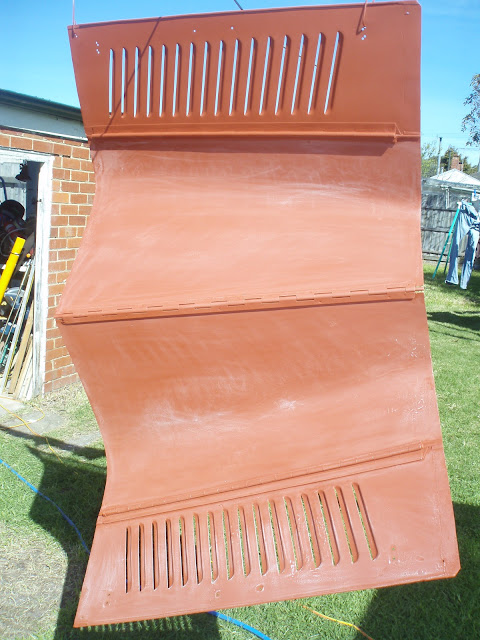Over the last two years, when time and good weather have allowed, I have been refinishing a friend's 1932 Austin 7 Ace sports car. Just another reason the Zephyr is not yet ready for the road.
The finished paint job
Two years ago; first undercoats on. Many hours of sanding and repainting were required as it is 80 years old and had a good shunt up the rear before the mid fifties. I know this because the owner from this era is a member of the Austin 7 Club locally. Bits of oil can were found grafted in to the tail! Both sides were completely replaced as part of the panel work before it came to me.
This is what I started with; plenty of bog, ripples, hollows and scratch marks from the panel work. One of the guards got a few spots of rain on it, so had to be reprimed and painted. The joys of having to work outdoors!
The rear guard primed for the second time. A couple of ripples can still be seen near the trailing edges of this guard even at this stage.
Rear guard top coat fresh off the gun.
Celebrity endorsed paint job!
Sparkling Monza red after cutting back with 1200 grit and machine polishing with two grades of cutting compound. Swirl remover is next.
Painting the bonnet presented some challenges.
Primed and the inside painted red.
Spot putty was next followed by heavy coats of primer over the block sanded filler. This process is repeated a number of times to achieve the desired smooth finish. Time was against me on this one and I didn't have the luxury of doing this 10 or more times to get it perfect.
A few days ago the car was driven here under it's own power for the first time. A sparkling new registration plate takes pride of place at the front and rear, having passed the Roadworthy Certificate examination earlier in the week. The front guard, valances and bonnet are still to be cut and polished.
 This is what makes it all worth while. It is great to see this beautifully proportioned car looking better than it did 50 years ago.
This is what makes it all worth while. It is great to see this beautifully proportioned car looking better than it did 50 years ago.
The hood is back with the upholsterer to make some changes.
The hood cover the first edition. The akward looking upright bits are being "smoothed over", after owner, Dennis, arranged a hinge to stow the section over windscreen flat when not fitted.
A very difficult windscreen to get watertight.
A "top" choice for fabric colour to go with the Monza red.
The Austin 7 Ace is a 4 cylinder 750cc four stroke engined motor car built in England and bodied here in Australia. Production of the 7 started in 1922 and continued until 1938. It was the British answer to the Model T, in many ways, being dubbed "the motor for the millions". This car has a four speed gearbox ith syncromesh on 3rd and 4th. Brakes are linked to all four wheels.
This Ace handles very well for a car of it's age and has surprisingly nippy performance.






























